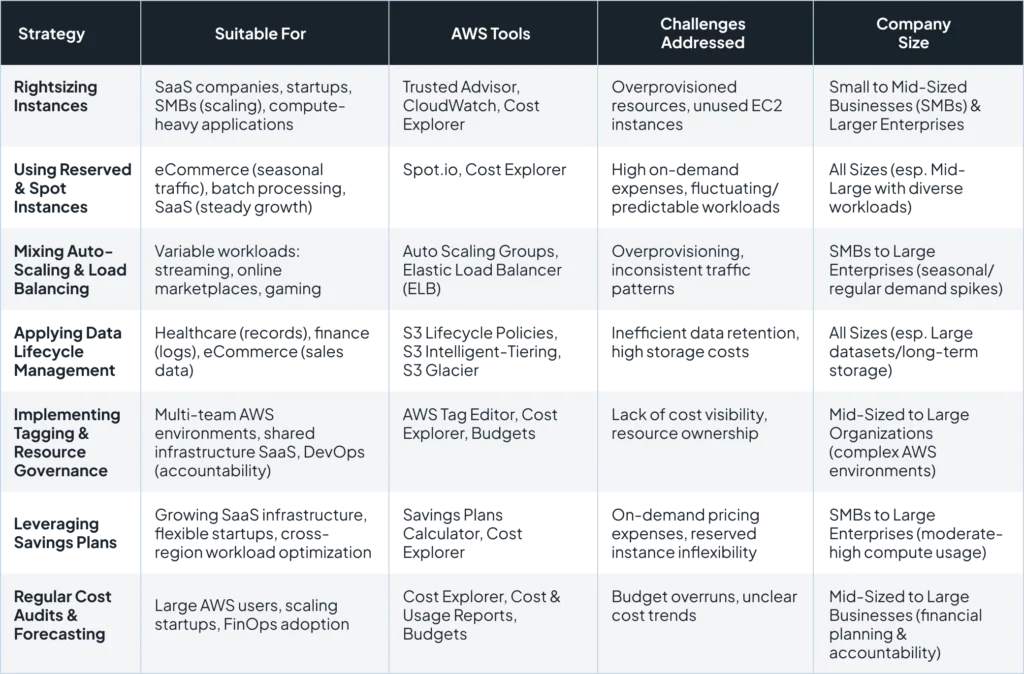AWS Cost Optimization: Strategies For Scaling Businesses Within Your Cloud Budget
- AWS cost optimization: The basic things to know
- Spotting the problem: Where AWS costs come out of control
- Benefits of AWS cost optimization across the board
- 7 key AWS cost optimization strategies
- Role of FinOps in AWS cost optimization
- AWS cost management tools and technologies
- Instead of conclusion: 5 steps to start with AWS cost optimization
No wonder Amazon Web Services has become one of the pillars of today’s digital economy, as it delivers flexibility, scalability, and agility. From small companies to large enterprises, AWS encourages businesses for innovation and growth. But here comes a challenge: effective cloud cost management. As businesses scale, AWS bills may come out of control, cutting into margins and forming financial uncertainty.
For companies seeking to get the most out of their cloud investment, AWS expense management offers a strategic opportunity to align their payments with business goals, enhance operational efficiency, and enable sustainable growth.
So, in this article, we’ll explore the core challenges of AWS cost management and effective optimization strategies, and how following best practices can lead to significant savings. Above that, we have a dedicated article with recommendations on cloud cost optimization, which we hope will strengthen your understanding of AWS cost reduction.
AWS cost optimization: The basic things to know
AWS provides flexibility and scalability, making it an almost irreplaceable tool for businesses, but these same benefits often lead to inefficiencies. Companies often overprovision resources for stronger reliability, forget to turn off unused instances, overlook efficient pricing models, or don’t use tools available in the AWS Management Console for cost-effective resource management. As a result, considerable amounts of cloud spending are often wasted due to nonfunctioning resources and poor resource allocation, significantly increasing the overall cost budget of cloud operations.
For businesses scaling rapidly or managing complex cloud architectures, these inefficiencies can quickly escalate. Without proper visibility into the key cost drivers and expertise in managing them, rising bills can suppress growth and deteriorate profitability, highlighting the need for effective tools to manage AWS expenses.
On the contrary, effective cost management allows to:
- Eliminate waste while maintaining performance to reduce your AWS costs effectively;
- Predict and control cloud spending for better budgeting;
- Release resources for strategic initiatives like product development or market expansion;
- Increase ROI;
- Enhance scalability;
- Maintain sustainability and energy efficiency;
The most important thing here is choosing the right way to do it.
Spotting the problem: Where AWS costs come out of control
As they say, identifying the problem is already half of the solution. So let’s review the most common ones where businesses lose their AWS resources.
- Lack of cost visibility – without precise cost monitoring, spotting areas of overspending becomes challenging for businesses as a whole and responsible departments specifically.
- Untracked resource usage – resources left running without proper supervision result in unnecessary expenses.
- Overprovisioning of resources – distribution of more compute, storage, or bandwidth than required boosts costs.
- Underutilized or idle resources – paying for used or underused resources wastes businesses’ budgets that could be redirected to other departments or purposes.
- Complex pricing models – navigating the cost structures of various AWS services can lead to discreet and unexpected expenses.
- Difficulty in predicting costs – without correct cost estimates, back-and-forth workloads and dynamic services may mislead expense predictions.
- Managing multi-account setups – disconnected billing across accounts interferes with cost tracking and management.
- Limited expertise in cost optimization – a lack of qualified experts can cause overlooked money-saving opportunities.
- Inefficient use of reserved instances or savings plans – mismanagement of long-term agreements diminishes potential savings.
- Rapidly evolving AWS services – constantly following new features and changes can result in overspending on unnecessary services.
- Data transfer costs – AWS customers often overlook high outbound or cross-region data transfer expenses, which can result in significant cost implications over time.
- Inadequate tagging strategy – improperly applied tagging restrains cost distribution and accountability.
- Unexpected costs from auto-scaling – automatic resource scaling can abruptly raise monthly bills, especially for growing companies.
- Spot instance interruption risks – sudden interruptions of spot instances can result in fail recovery expenses for a business’ on-demand resources.
- Integration of third-party tools – external tools with AWS integrations often fetch extra payments that only expand businesses’ bills.
Benefits of AWS cost optimization across the board
It’s impossible to underestimate the transformative force of effective AWS expense management and how it alters many business processes and aspects.
Long-term values
It might be obvious, but let’s clear things out to be on the same page.
Resources you put into managing AWS cloud expenses are your investments into the future.
Perhaps, you won’t see the results right away. However, in the long run, it will be quite feasible. Let’s see how exactly.
Fostering growth and scalability
Being guided by best practices for managing AWS expenses, businesses can reinvest their savings into growth-oriented ambitions, including launching new products, expanding to new markets, or scaling infrastructure to satisfy growing demand. Providing the precise alignment of cloud resources with operational needs allows companies to free up budgets and avoid substantial cost inefficiencies caused by unnecessary expenses. It encourages immediate growth and backs long-term scalability, allowing businesses to adjust to transforming market conditions without financial pressure.
Operational efficiency
Efficient cloud resource usage lowers waste and provides appropriate cost usage to businesses, according to their needs, which improves operational productivity across the board. Automation of tasks like scaling resources, managing idle instances, and adjusting storage tiers allows businesses to achieve significant resource optimization, minimizing manual intervention in cloud management. This helps engineering-related teams to focus on primary tasks, including application performance improvement or innovation instead of getting stuck in mundane infrastructure management.
Financial predictability and control
As already mentioned, managing cloud expenses wisely gives businesses real-time visibility into their cloud spending, simplifying expense forecasts and efficient budget allocation effectively. Implementation of monitoring tools, budget limits, and resources like the AWS Pricing Calculator delivers greater control over AWS costs to businesses and helps prevent unexpected spending bills that disrupt financial planning. This predictability streamlines daily cost management and creates confidence among all stakeholders in the business’s ability to uphold financial discipline while scaling operations.
How properly selected AWS engineers impact cost optimization
Picking the right AWS engineers plays a significant part in achieving efficient cloud expense management. Their expertise ensures efficient resource allocation, proactive monitoring, and customized cloud management strategies that correspond to business objectives.
Efficient resource configuration and allocation
AWS engineers confirm proper configuration for matching workload needs without overprovisioning. Practices like rightsizing instances, right pricing model selection (e.g., reserved or spot instances), storage tiers optimization – and choosing the most price-conscious AWS region help engineers reduce AWS costs while preserving application performance. They also apply automation tools like auto-scaling for dynamic resource adjustments based on real-time needs, eliminating excessive expenses throughout low-demand periods.
Mobilunity’s AWS engineers emphasize cloud environment assessment to apply savings-oriented techniques, creating savings-oriented configurations adjusted to business requirements. Their expertise in optimizing EC2, S3, and Lambda confirms businesses’ particular expenses for the resources they indeed need, lowering costs while maximizing performance.
Strategic monitoring and cost management
AWS developers usually apply monitoring instruments like AWS Cost Explorer, Trusted Advisor, and CloudWatch to analyze the cost of resource usage and recognize fallacies. They also utilize tools like AWS Compute Optimizer to identify overprovisioned resources and make informed decisions on instance resizing. By establishing alerts and dashboards for real-time findings into cloud spending, they encourage prompt action to manage expense anomalies. This approach cuts potential costs by spotting unused or ignored resources and enforcing automated cost controls.
Mobilunity’s certified developers are experts in placing and managing extensive monitoring frameworks for their clients. Our engineers’ ability to predict cost surges and execute preventive measures secures businesses to uphold predictable AWS bills and perform within budget.
Customized optimization strategies aligned with business goals
Proficient developers often keep in mind optimization strategies that match a company’s distinctive workloads, usage patterns, and growth pursuits. Understanding specific business requirements allows them to create tailored solutions like lifecycle policies for data storage, workload prioritization for compute resources, and compliance-aware configurations. These customized strategies reduce costs and confirm the scalability and long-term growth of those AWS infrastructures.
Mobilunity’s AWS-certified engineers specialize in aligning optimization strategies tailored for diverse industries including SaaS, Retail, E-commerce, Insurtech, and Fintech. Their background in fitting AWS configurations to business priorities helps clients achieve considerable cost savings while concentrating on innovation and expansion.
AWS cost optimization impact across industries
No secret that businesses across industries heavily rely on AWS cloud infrastructure. So let SaaS, Retail, and Insurtech be showing examples for us to watch how tailored strategies address each industry’s distinctive challenges.
Efficient scalability and innovation driver for SaaS
The SaaS industry leans on AWS to provide scalable, high-performance applications to global users. With the growth of user bases, managing expenses guarantees efficient usage of cloud resources without sacrificing uptime or performance. Adoption of such strategies as rightsizing instances, storage tiers optimization, and leveraging auto-scaling allows SaaS companies to align their AWS use with workload needs.
These adjustments release resources for reinvestment in designing new features or enhancing user experiences. AWS cost management promotes SaaS businesses’ scalability while keeping on the float of a rapidly evolving market.
Handling seasonal demand and maximizing profitability for the retail sector
Without AWS cost optimization, the retail industry wouldn’t be able to manage fluctuating traffic throughout prime shopping periods like Black Friday or the Christmas holiday season. Retailers can apply dynamic auto-scaling to address high demand while lessening waste during off-peak spans. Usage of spot instances for non-critical workloads and optimization of backend processes allow retail businesses to secure cost efficiency without giving up on customer satisfaction.
Storage optimization strategies are also significant in large datasets management, including product catalogs and customer analytics. Effective cost management promotes profitability for retailers, provides operational continuity, and enhances overall shopping experiences throughout the year.
Balancing compliance and cost efficiency in the Insurtech Industry
Insurtech companies increasingly use AWS to boost advanced analytics, AI-driven risk models, and customer-centric platforms. As the industry in general processes large volumes of sensitive data while sticking to strict regulatory requirements like GDPR and PCI DSS, cost optimization is an integral element here. Such strategies as data lifecycle management, which archives idle data to lower-cost storage tiers, and rightsizing compute resources, foster efficient and compliant use of AWS.
Reduction of excessive expenses empowers Insurtech companies for larger resource distribution to innovation, including AI-based claims processing or personalized insurance products. AWS cost optimization allows Insurtech providers to uphold compliance, lower operational costs, and adjust to changing industry conditions.
7 key AWS cost optimization strategies
Now, let’s move from values and impacts to AWS cost optimization best practices to approach and solve the concerns.
The table breaks down each strategy also considering relatable business models, company sizes, challenges addressed, and fitting AWS tools.

And here’s a more detailed description of strategies for AWS cost optimization.
Rightsizing instances
Rightsizing relates to examining workload requirements and adapting EC2 instances to match the exact needs of a business application. This confirms that businesses avoid overpaying for unused resources, such as oversized instances. Review of CPU, memory, and storage usage through monitoring solutions such as AWS CloudWatch, AWS Compute Optimizer, and Trusted Advisor allows companies to resize or replace instances for cost reduction while keeping performance. This strategy is specifically useful in combination with regular reviews, guaranteeing that cloud environments remain budget-conscious throughout workload evolvement.
- Suitable for: SaaS companies, startups, and SMBs scaling rapidly or businesses running compute-heavy applications like data analytics platforms.
- AWS tools: Trusted Advisor, CloudWatch, and Cost Explorer.
- Challenges addressed: Overprovisioned resources and unused EC2 instances.
- Company sizes: Small to mid-sized businesses (SMBs) and larger enterprises managing growing or dynamic cloud infrastructures.
Using reserved and spot instances
Reserved instances deliver cost savings for predictable workloads because they allow businesses to lock in a lower price by committing to a specific instance type and region over a specified duration. Meanwhile, spot instances suggest steep discounts for workloads handling interruptions, like batch processing, testing, or low-priority tasks. A thought-through combination of reserved and spot instances enables companies for significant optimization of their compute costs while retaining flexibility for dynamic workloads.
- Suitable for: eCommerce platforms managing seasonal traffic spikes, enterprises running batch processing jobs, and SaaS companies with steady user growth.
- AWS tools: Spot.io (for automated spot instance management), AWS Cost Explorer (to identify predictable workloads).
- Challenges addressed: High expenses from on-demand pricing, fluctuating or predictable workloads.
- Company sizes: All sizes, particularly mid-to-large companies with diverse workload types.
Mixing up auto-scaling and load balancing
Auto-scaling automatically accommodates the number of resources to fit demand, confirming that businesses only pay for what they use. Load balancing optimizes traffic distribution across instances to maximize resource usage. All combined, they prevent overprovisioning during low-traffic periods while guaranteeing scalability during request surges. This approach is particularly suitable for businesses with fluctuating user traffic, boosting performance without excessive costs.
- Suitable for: Businesses with highly variable workloads, such as streaming services, online marketplaces, and gaming platforms.
- AWS tools: Auto Scaling Groups, Elastic Load Balancer (ELB).
- Challenges addressed: Overprovisioned resources and inconsistent traffic patterns.
- Company sizes: SMBs to large enterprises experiencing regular or seasonal spikes in demand.
Applying data lifecycle management
Data lifecycle management includes organization and automation of data storage based on its significance and frequency of access. Businesses can reserve rarely accessed data in lower-cost storage classes like S3 Glacier or S3 Intelligent-Tiering while using higher-cost tiers for maintaining continually accessed data. Archiving or deleting outdated data allows businesses and institutions to cut storage costs while fulfilling compliance requirements for data retention.
- Suitable for: Healthcare providers managing medical records, financial institutions storing transaction logs, and eCommerce companies retaining historical sales data.
- AWS tools: S3 Lifecycle Policies, S3 Intelligent-Tiering, S3 Glacier.
- Challenges addressed: High storage costs due to inefficient data retention practices.
- Company sizes: All sizes, particularly companies dealing with large datasets or long-term storage requirements.
Implementing tagging and resource governance
Tagging resources with metadata, including cost allocation tags for departments, projects, or environments allows businesses for accurate cost distribution and neglected asset identification. Governance frameworks secure consistent resource usage, avoiding overspending due to ignored resources. In a blend with such solutions as AWS Cost Explorer and Budgets, tagging boosts granular tracking and accountability, promoting cost-conscious resource management.
- Suitable for: Enterprises managing multi-team AWS environments, SaaS companies with shared infrastructure, and DevOps teams with resource accountability needs.
- AWS tools: AWS Tag Editor, Cost Explorer, AWS Budgets.
- Challenges addressed: Lack of visibility into resource ownership and difficulty in tracking cloud expenses
- Company sizes: Mid-sized to large organizations with complex AWS environments.
Leveraging Savings Plans
Savings Plans suggest adjustable pricing models that lower costs on AWS Lambda, EC2, and AWS Fargate usage as a trade for a commitment to a precise amount of compute usage over a period. Unlike reserved instances, Savings Plans deliver flexibility across instance types, regions, and operating systems, which makes them appropriate for businesses with fluctuating workloads. Usage forecast and commitment to a Savings Plan allow companies to reduce costs without compromising on a specific arrangement.
- Suitable for: SaaS companies with growing infrastructure needs, startups seeking flexibility, and enterprises optimizing cross-region workloads.
- AWS tools: AWS Savings Plans Calculator, Cost Explorer.
- Challenges addressed: High expenses due to on-demand pricing and lack of flexibility in reserved instance commitments.
- Company sizes: SMBs to large enterprises with moderate-to-high compute usage.
Regular cost audits and forecasting
Completing regular cost audits confirms that businesses keep updated about their AWS spending, recognizing inefficiencies or abnormalities in resource use. Prediction of future AWS spending and usage patterns based on historical data, combined with a comprehensive cost breakdown, allows businesses to reduce AWS expenses, arrange their budgets effectively, and prevent accidental cost spikes. Such instruments as AWS Budgets and Cost and Usage Reports allow businesses to establish spending limits and manage their cloud backgrounds.
- Suitable for: Large AWS users, startups scaling rapidly, and companies adopting FinOps practices.
- AWS tools: AWS Cost Explorer, Cost and Usage Reports, Budgets.
- Challenges addressed: Budget overruns and lack of visibility into cost trends.
- Company sizes: Mid-sized to large businesses prioritizing financial planning and accountability.
Role of FinOps in AWS cost optimization
FinOps, an emerging discipline, takes a separate and highly significant role in optimizing AWS expenses.
But first things first.
FinOps, short for Financial Operations, connects finance, engineering, and operations teams to cooperate on efficient cloud cost oversight. It amplifies cloud spending alignment with business goals, encouraging financial accountability and budget efficiency.
As for the AWS cost aspect, FinOps supplies businesses with the framework and tools required for organizations to follow, assess, and optimize their cloud usage while allowing teams for informed decisions about resource distribution.
FinOps principles deliver better visibility into their AWS spending, fix clear budget objectives, and encourage cross-functional teams to collaborate to control expenses. It shifts cloud cost management from a reactive practice into a proactive strategy that fosters growth, innovation, and scalability.
Promoting financial accountability across parties
FinOps guarantees that every team – whether finance, engineering, or operations, takes responsibility for their role in cloud cost management. Specifying clear ownership of resources and budgets encourages accountability with every decision-maker understanding the impact of their choices on AWS spending. This communicated responsibility leads to more thoughtful decisions, diminishing waste and fostering efficient resource usage.
Enabling real-time visibility and cost control
One of the key advantages of FinOps is its priority in real-time monitoring and cost transparency, providing companies with visibility of the roots of their AWS expenses. With tools like AWS Budgets, Cost Explorer, and third-party platforms, FinOps allows teams to follow spending trends, catch inefficiencies, and make immediate corrections. This visibility secures the opportunity to avoid unpredictable cost surges and remain within their distributed budgets.
Driving collaboration for sustainable optimization
FinOps focuses on cooperation between technical and financial teams to blend expense efficiency, performance, and scalability. Developers and finance teams collaborate to assess trade-offs, like picking between reserved and on-demand instances or optimizing storage tiers for various workloads. This cross-functional partnership guarantees financial considerations for technical decisions, which results in more sustainable cloud spending practices.
AWS cost management tools and technologies
Now that we have a deeper understanding of the AWS cost optimization concept, let’s review instruments that make business-related cost operations easier. We’ve already mentioned some of them when talking about cost optimization strategies. The majority are suggested by Amazon itself, and others – by additional platforms.
AWS-native tools
AWS offers a number of tools to support businesses with efficient cost tracking and expense optimization.
- AWS Cost Explorer. Businesses that use AWS Cost Explorer get a user-friendly tool that allows businesses to analyze historical and present usage patterns, helping recognize inefficiencies in resource allocation. It gives visualizations and insights into spending trends, allowing for data-driven decisions for cost optimization.
- AWS Cost Explorer. Businesses that use AWS Cost Explorer get a user-friendly tool that allows businesses to analyze historical and present usage patterns, helping recognize inefficiencies in resource allocation. It gives visualizations and insights into spending trends, allowing for data-driven decisions for cost optimization.
- AWS Trusted Advisor. This instrument presents actionable suggestions to improve budget efficiency, boost system performance, provide security, and uphold fault tolerance. Thus, recognizing neglected resources, misconfigurations, and budget-saving opportunities empowers organizations to adjust their cloud infrastructure.
- AWS Budgets. The mechanism enables businesses to establish custom spending thresholds across their AWS accounts and accept alerts when costs exceed those limits. This foreseeing approach guarantees that teams can stay within budget while scheduling for coming cloud expenses.
- S3 Lifecycle Policies. The tool enables businesses to automate data movement between different Amazon S3 storage classes based on their lifecycle. For instance, repeatedly accessed data can stay in S3 Standard, while less active data can be transferred to lower-cost tiers like S3 Glacier after a fixed term. This automation relieves manual effort and guarantees businesses spending, particularly on the storage class, accessing their data at any given time, which optimizes costs without giving up on accessibility.
- S3 Intelligent-Tiering. This storage class is created for automated data movement between access tiers based on usage patterns. Repeatedly accessed data stays in a higher-tier storage class, while rarely accessed data is redirected to lower-cost tiers. This mechanism is a good fit for unpredictable access patterns because it eliminates the necessity of manual data management while securing storage cost minimization.
- S3 Glacier. This low-cost storage solution aims at archiving rarely accessed data but those to be retained for long durations, including compliance records or backups. While retrieval times may last for several hours, the extremely low storage costs make it a first choice for cold data. Companies can operate Glacier to keep large volumes of archival data at minimal expense while providing long-term durability and protection.
Advanced third-party solutions
Meanwhile, companies with complex cloud architectures can benefit from third-party tools with deeper insights and enriched capabilities:
- CloudHealth. This comprehensive cloud management platform suggests detailed analytics and governance tools for AWS usage and cost optimization. Its customizable dashboards and reporting features present spending trends, provide compliance, and level up financial governance across multi-cloud environments.
- Spot.io. The tool automates the management of AWS spot instances, securing maximum budget efficiency as compared to on-demand pricing without sacrificing workload reliability. Its dynamic resource reallocation and interruption management allow businesses to save significantly on compute costs for optional or batch-processing tasks.
- Kubecost. The instrument focuses on cost monitoring and optimization for Kubernetes environments, delivering real-time visibility into microservices, containers, and clusters. It helps teams with accurate expense allocation, identifies inefficiencies, and guarantees containerized workloads remain price-efficient while sustaining scalability and performance.
Instead of conclusion: 5 steps to start with AWS cost optimization
So, let’s recap here.
What should businesses do to initiate a proper cost optimization process? Here’s our checklist:
- Estimate your current AWS usage. Examine your existing AWS usage patterns, resource distribution, and spending. Use the AWS Cost Explorer and Trusted Advisor to identify inefficiencies like ignored instances, inactive resources, or excessive services.
- Specify budget goals and prioritize areas for optimization. Set a clear budget for your AWS environment and determine high-impact areas for budget savings, including compute, storage, or network usage. Prioritize optimization of the components that cause the majority of your cloud payments.
- Implement tagging and use suitable pricing models. Select a tagging strategy to follow resource ownership and usage for clearer accountability. Estimate workloads to commit predictable tasks to reserved instances or Savings Plans and employ spot instances for flexible, secondary tasks.
- Automate and optimize resource management. Enable auto-scaling and lifecycle policies for dynamic resource adjustment based on demand and archive rarely accessed data to lower-cost storage tiers. This approach will provide efficient resource provision, avoiding waste and unnecessary expenses.
- Monitor costs and regularly review your strategy. Implement AWS Budgets and Cost and Usage Reports for tracking spending and forecasting fluctuations in resource demands. Cooperate with AWS-certified experts to complete regular audits and refine your cost optimization strategy along with the growth of your business.
Of course, as we’ve already seen, managing AWS expenses requires thorough considerations, but this short dive-in can give you a clear roadmap to start optimizing your AWS costs effectively while aligning cloud spending with your company’s goals.
And if you need support or advice on your decisions, you can always contact us.













